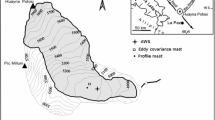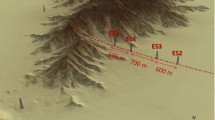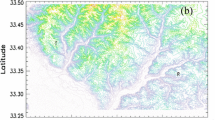Abstract
The measurements taken during the Vertical Transport and Mixing Experiment (VTMX, October, 2000) on a northeastern slope of Salt Lake Valley, Utah, were used to calculate the statistics of velocity fluctuations in a katabatic gravity current in the absence of synoptic forcing. The data from ultrasonic anemometer-thermometers placed at elevations 4.5 and 13.9 m were used. The contributions of small-scale turbulence and waves were isolated by applying a high-pass digital (Elliptical) filter, whereupon the filtered quantities were identified as small-scale turbulence and the rest as internal gravity waves. Internal waves were found to play a role not only at canonical large gradient Richardson numbers \((\overline{\hbox {Ri}_\mathrm{g} } >1)\), but sometimes at smaller values \((0.1 < \overline{\hbox {Ri}_\mathrm{g}}<1)\), in contrast to typical observations in flat-terrain stable boundary layers. This may be attributed, at least partly, to (critical) internal waves on the slope, identified by Princevac et al. [1], which degenerate into turbulence and help maintain an active internal wave field. The applicability of both Monin-Obukhov (MO) similarity theory and local scaling to filtered and unfiltered data was tested by analyzing rms velocity fluctuations as a function of the stability parameter z/L, where L is the Obukhov length and z the height above the ground. For weaker stabilities, \(\hbox {z/L}<1\), the MO similarity and local scaling were valid for both filtered and unfiltered data. Conversely, when \(\hbox {z/L}>1\), the use of both scaling types is questionable, although filtered data showed a tendency to follow local scaling. A relationship between z/L and \(\overline{\hbox {Ri}_\mathrm{g} }\) was identified. Eddy diffusivities of momentum \(\hbox {K}_\mathrm{M}\) and heat \(\hbox {K}_\mathrm{H}\) were dependent on wave activities, notably when \(\overline{\hbox {Ri}_\mathrm{g} } > 1\). The ratio \(\hbox {K}_{\mathrm{H}}/\hbox {K}_{\mathrm{M}}\) dropped well below unity at high \(\overline{\hbox {Ri}_\mathrm{g} }\), in consonance with previous laboratory stratified shear layer measurements as well as other field observations.














Similar content being viewed by others
References
Princevac M, Hunt JCR, Fernando HJS (2008) Quasi-steady katabatic winds over long slopes in wide valleys. J Atmos Sci 65(2):627–643
Whiteman CD (2000) Mountain meteorology: fundamentals and applications. Oxford University Press, Oxford
Fernando HJS (2010) Fluid dynamics of Urban atmospheres in complex terrain. Annu Rev Fluid Mech 42:365–389
Fernando HJS, Weil J (2010) An essay: whither the SBL? - A shift in the research agenda. B Am Meteorol Soc 91(11):1475–1484
Nieuwstadt FTM (1984) The turbulent structure of the stable, nocturnal boundary layer. J Atmos Sci 41:2202–2216
King JC (1990) Some measurements of turbulence over an Antarctic ice shelf. Q J Roy Meteor Soc 116:379–400
Mahrt L, Sun J, Jensen NO, Blumen W, Delany T, Oncley S (1998) Nocturnal boundary-layer regimes. Bound-Lay Meteorol 88:255–278
Van de Wiel BJH, Moene AF, Hartogensis OK, De Bruin HAR, Holtslag AAM (2003) Intermittent turbulence in the stable boundary layer over land. Part III: a classification for observations during CASES-99. J Atmos Sci 60:2509–2522
Van der Avoird E, Duynkerke PG (1999) Turbulence in a katabatic flow. Bound-Lay Meteorol 92:39–66
Munro DS, Davies JA (1978) On fitting the log-linear model to wind speed and temperature profiles over a melting glaciers. Bound-Lay Meteorol 15:423–437
Mahrt L (1998) Stratified atmospheric boundary layers and breakdown of models. Theoret Comput Fluid Dyn 11:263–279
Smedman AS (1988) Observations of a multi-level turbulence structure in a very stable atmospheric boundary layer. Bound-Lay Meteorol 44:231–253
Högström U (1990) Analysis of turbulent structures in the surface layer with a modified similarity formulation for near neutral conditions. J Atmos Sci 47:1949–1972
Monti P, Fernando HJS, Princevac M, Chan WC, Kowalewski TA, Pardyjak ER (2002) Observations of flow and turbulence in the nocturnal boundary layer over a slope. J Atmos Sci 59(17):2513–2534
DeSilva IPD, Imberger J, Ivey G (1997) Localized mixing due to a breaking internal wave ray at a sloping bed. J Fluid Mech 350:1–27
Bretherton FP (1969) Waves and turbulence in stably stratified fluids. Radio Sci 4(12):1279–1287
Finnigan J (1999) A note on wave-turbulence interaction and the possibility of scaling the very stable boundary layer. Bound-Lay Meteorol 90:529–539
Mahrt L, Vickers D, Sun J, Jensen NO, Jørgensen H, Pardyjak E, Fernando HJS (2001) Determination of the surface drag coefficient. Bound-Lay Meteorol 99:249–276
Doran JC, Fast JD, Horel J (2002) The VTMX 2000 campaign. B Am Meteorol Soc 83(4):537–554
Gibson CH (1980) Fossil temperature, salinity, and vorticity turbulence in the ocean. In: Nihoul J (ed) Marine Turbulence. Elsevier Publishing Co., Amsterdam, pp 221–257
McEwan AD (1983a) Internal mixing in stratified fluids. J Fluid Mech 128:59–80
McEwan AD (1983b) The kinematics of stratified mixing through internal wave breaking. J Fluid Mech 128:47–58
Fernando HJS (1991) Turbulent mixing in stratified fluids. Ann Rev Fluid Mech 23:455–493
Corral C (2000) Designing elliptic filters with maximum selectivity. In: Energy for the design mind (EDN), design feature, Motorola Inc, Schaumburg
Stull RB (1988) An introduction to boundary layer meteorology. Kluwer Academic Publisher, Dordrecht
Businger JA, Wyngaard JC, Izumi Y, Bradley EF (1971) Flux profile relationships in the atmospheric surface layer. J Atmos Sci 28:181–189
De Bruin HAR, Kohsiek W, van den Hurk JJM (1993) A verification of some methods to determine the fluxes of momentum, sensible heat, and water vapour using standard deviation and structure parameter of scalar meteorological quantities. Bound-Lay Meteorol 63:231–257
Pahlow M, Parlange MB, Porté-Agel F (2001) On monin-obukhov similarity theory in the stable atmospheric boundary layer. Bound-Lay Meteorol 99:225–248
Heinemann G (2004) Local similarity properties of the continuously turbulent stable boundary layer over Greenland. Bound-Lay Meteorol 112:283–305
Zardi D, Whiteman CD (2012) Chapter 2 in diurnal mountain wind systems. In: Chow FK, DeWekker SFJ, Snyder B (eds) Mountain weather research and forecasting. Springer, Berlin, pp 35–119
Moraes OLL, Acevedo OC, Da Silva R, Magnago R, Siquera AC (2004) Nocturnal surface-layer characteristics at the bottom of a valley. Bound-Lay Meteorol 112:159–177
Malhi YS (1995) The significance of the dual solutions for the heat fluxes measured by the temperature fluctuation method in stable conditions. Bound-Lay Meteorol 74:389–396
Rotter J, Fernando HJS, Kit E (2007) Evolution of a forced stratified mixing layer. Phys Fluids 19(065107): 1–10
Strang EJ, Fernando HJS (2001) Vertical mixing and transport through a stratified shear layer. J Phys Oceanogr 31:2026–2048
Strang EJ, Fernando HJS (2001) Entrainment and mixing in stratified shear flows. J Fluid Mech 428:349–386
Mahrt L, Vickers D (2003) Formulation of turbulent fluxes in the stable boundary layer. J Atmos Sci 60:2538–2548
Monti P, Querzoli G, Cenedese A, Piccinini S (2007), Mixing properties of a stably stratified parallel shear layer. Phys Fluids 19(085104): 1–9
Shumann U, Gerz T (1995) Turbulent mixing in stably stratified shear flows. J Appl Meteor 34:33–48
Lee SM, Giori W, Princevac M, Fernando HJS (2006) A new turbulent parameterization for the nocturnal PBL over complex terrain. Bound-Lay Meteorol 119:109–134
Acknowledgments
The data analysis was performed with the support of Office of Naval Research Award # N00014-11-1-0709, Mountain Terrain Atmospheric Modeling and Observations (MATERHORN) Program.
Author information
Authors and Affiliations
Corresponding author
Rights and permissions
About this article
Cite this article
Monti, P., Fernando, H.J.S. & Princevac, M. Waves and turbulence in katabatic winds. Environ Fluid Mech 14, 431–450 (2014). https://doi.org/10.1007/s10652-014-9348-1
Received:
Accepted:
Published:
Issue Date:
DOI: https://doi.org/10.1007/s10652-014-9348-1




